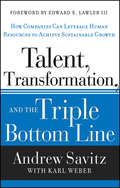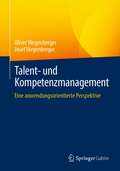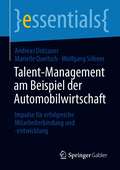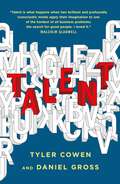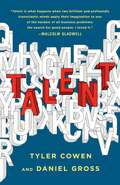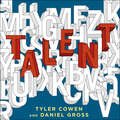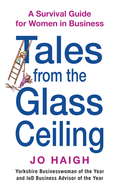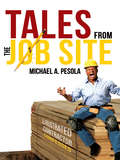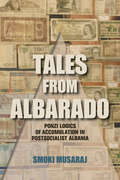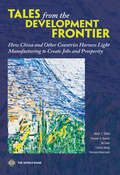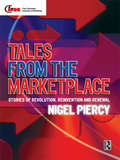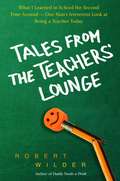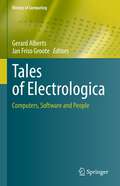- Table View
- List View
Talent, Transformation, and the Triple Bottom Line
by Karl Weber Edward E. Lawler III Andrew SavitzHR Professional's guide to creating a strategically sustainable organization Employees are central to creating sustainable organizations, yet they are left on the sidelines in most sustainability initiatives along with the HR professionals who should be helping to engage and energize them. This book shows business leaders and HR professionals how to: motivate employees to create economic, environmental and social value; facilitate necessary culture, strategic and organizational change; embed sustainability into the employee lifecycle; and strengthen existing capabilities and develop new ones necessary to support the transformation to sustainability.Talent, Transformation, and the Triple Bottom Line also demonstrates how leading companies are using sustainability to strengthen core HR functions: to win the war for talent, to motivate and empower employees, to increase productivity, and to enliven traditional HR-related efforts such as diversity, health and wellness, community involvement and volunteerism. In combination, these powerful benefits can help drive business growth, performance, and results.The book offers strategies, policies, tools and specific action steps that business leaders and HR professionals can use to get into the sustainability game or enhance their efforts dramatically Andrew Savitz is an expert in sustainability and has worked extensively with many organizations on sustainability strategy and implementation; he and Karl Weber wrote The Triple Bottom Line, one of the most successful books in the field Published in partnership with SHRM and with the cooperation of the World Business Council for Sustainable DevelopmentForward by Edward Lawler IIIThis book fills a gaping hole in both the HR and sustainability literature by educating HR professionals about sustainability, sustainability professionals about HR, and business leaders about how to marry the two to accelerate progress on both fronts.
Talent- und Kompetenzmanagement: Eine anwendungsorientierte Perspektive
by Oliver Wegenberger Josef WegenbergerDieses Buch bietet eine umfassende Darstellung des Talent- und Kompetenzmanagements in übersichtlicher Form. Es dient Führungskräften, HR-Verantwortlichen wie auch Betriebsräten, Beratern und Studierenden als nützliche Informationsquelle für die Themen Kompetenzmanagement, Personalplanung, Personalauswahl, Entwicklung und Onboarding sowie das gesamte Spektrum des Human Potential Managements. Abgestimmte Tools, Instrumente und wichtige Leitfäden ermöglichen die direkte Umsetzung in die betriebliche Praxis.
Talent-Management am Beispiel der Automobilwirtschaft: Impulse für erfolgreiche Mitarbeiterbindung und -entwicklung (essentials)
by Andreas Dotzauer Marielle Queitsch Wolfgang SöhnerTalent-Management (TM) ist ein wichtiger Bereich der betrieblichen Personalarbeit. Das essential bietet fundierte Informationen: Definition, Ansätze, Ziele, Erfolgsfaktoren, Vor- und Nachteile sowie Kernprozesse. Mit Personalexperten und Young Professionals aus der Automobilbranche wurden Interviews geführt. Abgeleitete Handlungsempfehlungen ermöglichen die Reflexion bzw. Professionalisierung – nicht nur in der Automobilwirtschaft.
Talent: How to Identify Energizers, Creatives, and Winners Around the World
by Daniel Gross Tyler CowanHow do you find talent with a creative spark? To what extent can you predict human creativity, or is human creativity something irreducible before our eyes, perhaps to be spotted or glimpsed by intuition, but unique each time it appears?The art and science of talent search get at exactly those questions. Renowned economist Tyler Cowen and venture capitalist and entrepreneur Daniel Gross guide the reader through the major scientific research areas relevant for talent search, including how to conduct an interview, how much to weight intelligence, how to judge personality and match personality traits to jobs, how to evaluate talent in on-line interactions such as Zoom calls, why talented women are still undervalued and how to spot them, how to understand the special talents in people who have disabilities or supposed disabilities, and how to use delegated scouts to find talent.Identifying underrated, brilliant individuals is one of the simplest ways to give yourself an organizational edge, and this is the book that will show you how to do that. It is both for people searching for talent, and for those being searched and wish to understand how to better stand out.
Talent: How to Identify Energizers, Creatives, and Winners Around the World
by Tyler Cowen Daniel GrossThe art and science of talent search: how to spot, assess, woo, and retain highly talented people.How do you find talent with a creative spark? To what extent can you predict human creativity, or is human creativity something irreducible before our eyes, perhaps to be spotted or glimpsed by intuition, but unique each time it appears?Obsessed with these questions, renowned economist Tyler Cowen and venture capitalist and entrepreneur Daniel Gross set out to study the art and science of finding talent at the highest level: the people with the creativity, drive, and insight to transform an organization and make everyone around them better.Cowen and Gross guide the reader through the major scientific research areas relevant for talent search, including how to conduct an interview, how much to weight intelligence, how to judge personality and match personality traits to jobs, how to evaluate talent in online interactions such as Zoom calls, why talented women are still undervalued and how to spot them, how to understand the special talents in people who have disabilities or supposed disabilities, and how to use delegated scouts to find talent. Talent appreciation is an art, but it is an art you can improve through study and experience.Identifying underrated, brilliant individuals is one of the simplest ways to give yourself an organizational edge, and this is the book that will show you how to do that. Talent is both for people searching for talent and for those who wish to be searched for, found, and discovered.
Talent: How to Identify Energizers, Creatives, and Winners Around the World
by Tyler Cowen Daniel GrossVital and impactful strategies on how to spot, assess, woo, and retain highly talented people. Find the people really capable of making a difference!How do you find talent with a creative spark? To what extent can you predict human creativity, or is human creativity something irreducible before our eyes, perhaps to be spotted or glimpsed by intuition, but unique each time it appears?The art and science of talent search get at exactly those questions. Renowned economist Tyler Cowen and venture capitalist and entrepreneur Daniel Gross guide the reader through the major scientific research areas relevant for talent search, including how to conduct an interview, how much to weight intelligence, how to judge personality and match personality traits to jobs, how to evaluate talent in on-line interactions such as Zoom calls, why talented women are still undervalued and how to spot them, how to understand the special talents in people who have disabilities or supposed disabilities, and how to use delegated scouts to find talent.Identifying underrated, brilliant individuals is one of the simplest ways to give yourself an organizational edge, and this is the audiobook that will show you how to do that. It is both for people searching for talent, and for those being searched and wish to understand how to better stand out.(P) 2022 Macmillan Audio
Talent@Tencent
by Shu Lin Tarun Khanna Nancy Hua DaiLate in 2016, two senior human resources (HR) executives at Tencent Holdings (Tencent), China's leading Internet services firm, are assessing the effectiveness of the company's talent management practices in responding to Tencent's sustained hypergrowth. Over the preceding decade, Tencent's revenues and earnings had grown at a compound annual rate (CAGR) of 38% and 44%, respectively. Its staff grew at a 25% CAGR, primarily by hiring recent college graduates. At the time of the case, the average Tencent worker was 29 years old, and worked at the firm for an average 3.24 years. Headquartered in the booming city of Shenzhen, China, Tencent benefited from rich pools of local entrepreneurship, capital, and skills, yet also lost employees to other opportunities catalyzed by those resources. The company therefore must do its utmost to attract, develop, and retain top talent: rivalry with its primary Chinese competitors, Alibaba and Baidu, is intensifying, and all three firms are increasingly looking to cultivate enterprise customers and to develop and sell products driven by new technologies, both in China and abroad.
TalentCorp Malaysia and the Returning Expert Programme
by William R. Kerr Alexis Brownell Danielle Li Mathis WagnerTalentCorp Malaysia runs the "Returning Expert Programme," a government program designed to encourage Malaysian professionals abroad to return home through use of various incentives. The REP is intended to combat the "brain drain" caused by highly-educated professionals moving away to take advantage of better career opportunities, by offering returnees benefits such as tax breaks and permanent residency for family members. In 2011, TalentCorp took over administration of the REP, and through adjustments to incentives and application requirements was able to dramatically increase the number of REP applicants and approvals. Now they are considering another set of changes and must demonstrate that their changes will increase "bang for the taxpayer buck," raising the number of applicants while maintaining the same level of quality.
Tales From The Glass Ceiling: A Survival Guide for Women in Business
by Jo Haigh12-14% of UK businesses are majority owned by women, a statistic that shows both the great strides women have made in business in the past two decades and how many obstacles still remain in a culture where 90% of the top roles are held by men. Jo Haigh has worked for many years in corporate finance, and has experienced these obstacles, and overcome them. In Tales from the Glass Ceiling, she offers women an inspirational guide to success in the male-dominated business world - a goal, that does not mean losing your identity. Haigh offers stories of success from many different areas of business, giving advice on how to reconcile an open, emotional disposition with an executive level's occasionally brutal atmosphere; how to spot the right training and development opportunities (and get them funded); how to overcome resistance to female leadership and how to build, manage and maintain your professional network. Based on Haigh's own experience as an executive and entrepreneur, and bolstered by the experiences and stories of other top women in their fields, Tales from the Glass Ceiling is an indispensable resource for all women in business.
Tales From The Glass Ceiling: A survival guide for women in business
by Jo Haigh12-14% of UK businesses are majority owned by women, a statistic that shows both the great strides women have made in business in the past two decades and how many obstacles still remain in a culture where 90% of the top roles are held by men. Jo Haigh has worked for many years in corporate finance, and has experienced these obstacles, and overcome them. In Tales from the Glass Ceiling, she offers women an inspirational guide to success in the male-dominated business world - a goal, that does not mean losing your identity. Haigh offers stories of success from many different areas of business, giving advice on how to reconcile an open, emotional disposition with an executive level's occasionally brutal atmosphere; how to spot the right training and development opportunities (and get them funded); how to overcome resistance to female leadership and how to build, manage and maintain your professional network. Based on Haigh's own experience as an executive and entrepreneur, and bolstered by the experiences and stories of other top women in their fields, Tales from the Glass Ceiling is an indispensable resource for all women in business.
Tales From the Job Site
by Michael A. PesolaThese stories are not meant to offend anyone. They are written merely to enlighten the reader to the intricacies of remodel work. Remodeling has long since overtaken new construction in dollars spent; therefore, it stands to reason that many contractors and homeowners out there have a story to tell. These stories can take many forms, from horror, to comedy, to yes, even success stories. My father taught my brothers and me most of what we know. He instilled in us a moral code that helped us to distinguish right from wrong and he taught us how to do things right the first time. God bless him, he is still with us teaching and guiding, albeit more now by example and nuance. Remodeling is like a chess game. Anyone can move, it's finishing that counts. If you're going to do something--anything--do it right. In the end, if these stories entertain you or provoke some thought during your remodel project, or if you can find some humor in the whole process, then I guess the book was worth it.
Tales From the Job Site
by Michael A. PesolaThese stories are not meant to offend anyone. They are written merely to enlighten the reader to the intricacies of remodel work. Remodeling has long since overtaken new construction in dollars spent; therefore, it stands to reason that many contractors and homeowners out there have a story to tell. These stories can take many forms, from horror, to comedy, to yes, even success stories. My father taught my brothers and me most of what we know. He instilled in us a moral code that helped us to distinguish right from wrong and he taught us how to do things right the first time. God bless him, he is still with us teaching and guiding, albeit more now by example and nuance. Remodeling is like a chess game. Anyone can move, it's finishing that counts. If you're going to do something--anything--do it right. In the end, if these stories entertain you or provoke some thought during your remodel project, or if you can find some humor in the whole process, then I guess the book was worth it.
Tales from Albarado: Ponzi Logics of Accumulation in Postsocialist Albania
by Smoki MusarajTales from Albarado revisits times of excitement and loss in early 1990s Albania, in which about a dozen pyramid firms collapsed and caused the country to fall into anarchy and a near civil war. To gain a better understanding of how people from all walks of life came to invest in these financial schemes and how these schemes became intertwined with everyday transactions, dreams, and aspirations, Smoki Musaraj looks at the materiality, sociality, and temporality of financial speculations at the margins of global capital. She argues that the speculative financial practices of the schemes were enabled by official financial infrastructures (such as the postsocialist free-market reforms), by unofficial economies (such as transnational remittances), as well as by historically specific forms of entrepreneurship, transnational social networks, and desires for a European modernity. Overall, these granular stories of participation in the Albanian schemes help understand neoliberal capitalism as a heterogeneous economic formation that intertwines capitalist and noncapitalist forms of accumulation and investment.
Tales from the Development Frontier
by Thomas G. Rawski Hinh T. Dinh Lihong Wang Xin Tong Eleonora Mavroeidi Pengfei Li Ali ZafarDespite widespread agreement among economists that labor-intensive manufacturing has contributed mightily to rapid development in China and other fast-growing economies, most developing countries have had little success in raising the share of manufacturing in production, employment, or exports. Tales from the Development Frontier recounts efforts to establish light manufacturing clusters in several Asian and African countries, looking in particular at China. A companion volume to Light Manufacturing in Africa--which laid out a strategy for injecting new industrial growth nodes into African economies--Tales from the Development Frontier focuses on the six main binding constraints to competitiveness that nascent light manufacturing industries must overcome in developing countries: the availability, cost, and quality of inputs; access to industrial land; access to finance; trade logistics; entrepreneurial capabilities, both technical and managerial; and worker skills. The volume systematically explores potential growth opportunities in light manufacturing in a carefully selected subset of industries: agribusiness, apparel, leather goods, wood-working, and metal products. It specifies the constraints that need to be addressed before local and international entrepreneurs can take advantage of the latent comparative advantage available to many low-income economies in the target industries. It also proposes policies to ease the constraints--policies that can open the door to rapid increases in industrial output, employment, productivity, and exports. The outcomes described in this volume include both inspiring successes and miserable failures in addressing the binding constraints in the identified sectors. These examples reveal how and why industrial development efforts in poor countries--where, by definition, underlying conditions are far from ideal--can accelerate growth. Most of the firms described in a series of case studies started from a very simple and modest base in an environment full of seemingly insurmountable obstacles. With its rich array of new material, this book will support the ongoing research of policy analysts focused on China and other developing countries. Above all, the volume aims to embolden business entrepreneurs and government officials in low-income countries to pursue newly emerging opportunities to expand and accelerate the growth of light manufacturing in their home economies.
Tales from the Marketplace (Cim Professional Development Ser.)
by Nigel F. Piercy'Tales from the Marketplace: Stories of Revolution, Reinvention and Renewal' is a highly innovative approach to building an understanding of the realities of market-led strategic change in companies. It provides an engaging, honest, and effective understanding of real market strategy in major organizations by focussing on the forces behind value-driven strategy. Nigel Piercy provides new and incisive insights into strategy and marketing through business "stories" that are contemporary and provocative. These new "stories" depict how major organizations have experienced revolution in their traditional markets - created by new types of competitors with new business models. The search for superior value is overtaking traditional brand and relationship strategies. The challenge to companies is reinvention and renewal and the alternative is obsolescence and decline. After all, did the major banks really expect to be competing with supermarkets, car companies, Virgin and internet-based companies to provide retail bank services?The book is based on the author's view that:· Business is exciting, turbulent and unpredictable - the "stories" we read and study should be too!· From Dell Computers and easyJet to Amazon.com and Skoda Cars, it is the most innovative companies that have most to teach us about reinvention and new business models· The inflexible analytical frameworks of the past no longer apply - "stories" of reinvention and renewal show the creative strategies developed by companies to cope with threats and exploit opportunities around them.'Tales from the Marketplace' is essential, timely and designed to be highly readable for managers. It also provides an innovative approach for undergraduate and MBA level teachers and students, and for participants on executive programmes in marketing and strategic management.
Tales from the Teachers' Lounge: What I Learned in School the Second Time Around -- One Man's Irreverent Look at Being a Teacher Today
by Robert WilderFrom the critically acclaimed author of "Daddy Needs a Drink" comes a series of irreverent, wickedly observant essays about what it really means to be a teacher today. By turns heartwarming, eye-opening, and uproariously funny, these pitch-perfect essays offer priceless lessons in life.
Tales of Electrologica: Computers, Software and People (History of Computing)
by Gerard Alberts Jan Friso GrooteManufacturing computers in series was quite a feat in the 1950s. As mathematical as it gets, the machines discussed here were called X1 and X8.The industrial achievement combined with the background in a mathematical research center made the company Electrologica a legend in Dutch computing. The tales in this book are told by those who have a right to tell. Highly engaged professionals take readers back to their pioneering work with the machines and in retrospect unveil some of the values, which went without saying in the 1960s. To disagree, Paul Klint relates the contrasting views on software in Dutch research traditions. ALGOL culture: Frans Kruseman Aretz takes the reader along to the detailed decisions on constructing compilers and shows the values of an ALGOL culture transpiring. Signposts: Dirk Dekker for the first time ‘owns’ his algorithm for mutual exclusion. In particle physics: René van Dantzig’s use case was an Electrologica X8 computer controlling two other computers in three-dimensional detection of colliding particles. Early steps in AI: Lambert Meertens’ tale of the X8 machine composing a violin quartet comes with his original presentation, as well as the code in ALGOL 60. The reflections of first hand experiences combine well with the second thoughts of historical research into archival sources. Historians Huub de Beer and Gerard Alberts offer a view into the boardrooms of the local enterprise Electrologica, and of the electronics multinational Philips. Where pioneers and historians meet in an inspiring dialogue, the reader gains a view on the often implicit decisions constituting the field.Fortuitously, a copy of the X8 was retrieved from Kiel, Germany, and put on display at Rijksmuseum Boerhaave, Leiden. Sparked by the very material presence of an X8, the present book takes stock of the state of historiography of Electrologica.Gerard Alberts is an associate professor in History of Digital Cultures, retired from the University of Amsterdam. Jan Friso Groote is a full professor of Formal Methods at the Eindhoven University of Technology.
Tales of Life-Changing Innovations: Fighting Hospital Infections ' Note on the Development of Cephalosporins (through 2000)
by Srikant M. Datar Amar V. Bhide Katherine StebbinsIndustry and Background Note
Tales of Life-changing Innovations: Beyond traditional X-rays ' Note on the Development of Computed Tomography (through the 1990s)
by Srikant M. Datar Amar V. Bhide Katherine StebbinsIndustry and Background Note
Tales of Life-changing Innovations: Containing a Fearsome Pandemic ' Note on the Development of HIV/AIDS Controls, Tests, and Treatments (through 2000)
by Srikant M. Datar Amar V. Bhide Katherine StebbinsIndustry and Background Note
Tales of Life-changing Innovations: Containing a Fearsome Pandemic ' Note on the Development of Prozac (through 1999)
by Srikant M. Datar Amar V. Bhide Katherine StebbinsIndustry and Background Note
Tales of Life-changing Innovations: Controversial Blockbuster ' Note on the Development of Prozac (through 1999)
by Srikant M. Datar Amar V. Bhide Katherine StebbinsIndustry and Background Note
Tales of Life-changing Innovations: Controversial Blockbuster ' Note on the Development of Prozac (through 1999)
by Srikant M. Datar Amar V. Bhide Katherine StebbinsIndustry and Background Note
